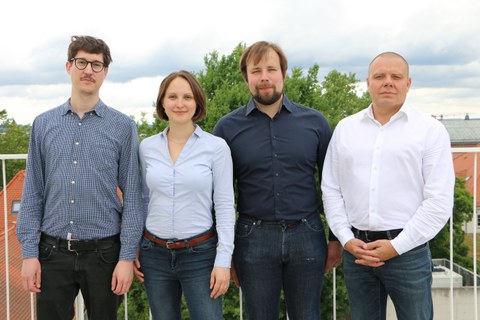Jul 01, 2021
Innovative materials for organic electronics by TUD founding team CREDOXYS
Organic electronics has taken off at a rapid pace over the last 10 years. In the smartphone and tablet sector as well as in TV sets, OLED displays are increasingly replacing liquid crystals ones. Likewise, organic photovoltaics (OPV) has made decisive steps in increasing efficiency and has reached market maturity.
"Organic optoelectronic devices only work based on different small molecules whose physical properties are perfectly matched," explains chemist and founding initiator Dr. Sascha Dorok. For more than 14 years, he has developed specialty chemicals for a wide range of industrial applications, including key materials that are now found in most commercial optoelectronic components. He is certain that the next generations of OLED displays and organic solar cells can only be realized with further advances in materials development.
Therefore he began working on his own ideas for new structure classes for organic electronics in 2014 and was looking for strong partners to found a company. CREDOXYS' founding team now comprises Dr. Julia Stolz, a physicist and specialist for optoelectronic components, Dr. Marcus Papmeyer, a process chemist with industrial experience, and Dr. Léonard Eymann, a synthesis chemist.
CREDOXYS aims to give its potential customers in the OLED display industry as well as in the OPV market a competitive edge with higher-performance materials, and to develop innovative materials for future technologies. Since June 2021, the project has received six-figure funding range under the EXIST Transfer of Research program of the German Federal Ministry for Economic Affairs and Energy. "The EXIST funding helps us to quickly develop our product ideas further as well as to provide initial test samples for customers in the OPV and OLED display sectors," Marcus Papmeyer is pleased to report. Already this summer, the company will be founded and the first funding round is to take place. "This will enable us to strengthen our team by hiring staff and to meet the first customer requests for larger material quantities," adds Julia Stolz.
The founding project CREDOXYS is located at the Dresden Integrated Center for Applied Physics and Photonic Materials (IAPP) of TU Dresden, which along with its director Prof. Karl Leo has a worldwide reputation for its discoveries and successful spin-offs in the field of organic electronics. Prof. Karl Leo also supports CREDOXYS as a mentor and co-founder with his wealth of experience.
EXIST Transfer of Research at a glance:
EXIST Transfer of Research supports outstanding research-based start-up projects from institutions of higher education and research institutions that involve complex and high-risk development work. The funding program of the Federal Ministry for Economic Affairs and Energy is co-financed by the European Social Fund (ESF). The ESF is one of the European Structural and Investment Funds.

